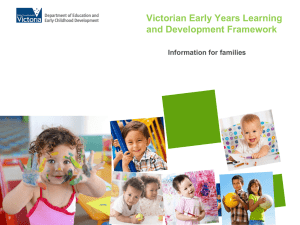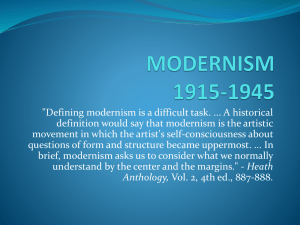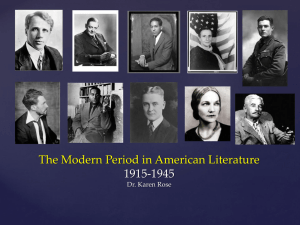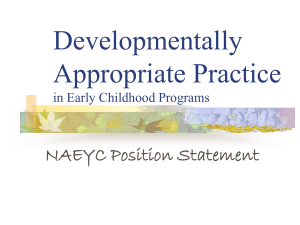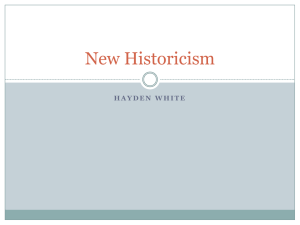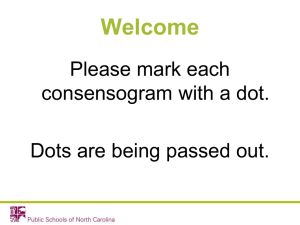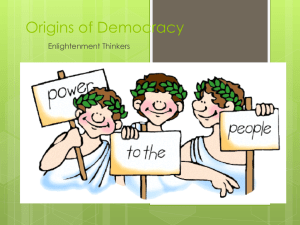The History of Children`s Literature
advertisement
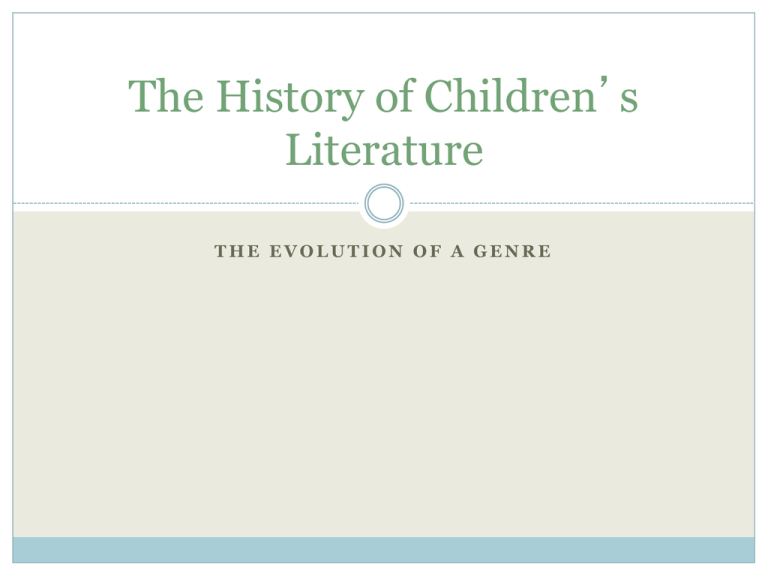
The History of Children’s Literature THE EVOLUTION OF A GENRE Shifting Attitudes Toward Childhood Stark realities involving childhood mortality adorn this page from the 1689 text A New England Primer. Shifting Attitudes Toward Childhood Imagination and play are emphasized in this 1951 book for children. Note that the central figures are children who are portrayed as glowing innocents – who are holding in gender-specific toys. Shifting Attitudes Toward Childhood In the West, the concept of childhood as a separate time of growth and development – as a time that should be set aside and given specific attention – did not emerge until the 16th century. The economic forces that led to the creation of a large, wealthy middle class combined with religious forces that placed a new emphasis on personal salvation and the result was an increased emphasis on education. In order to be financially sound and morally “right,” a person needed an education. Shifting Attitudes Toward Childhood Prior to this era, children had been an integral part of the adult world. Through their employment as farm workers, apprentices, and servants, they were privy to adult discussions and were expected to exhibit adult behavior (Ariès 45). By the 19th century, the passage of mandatory education and child labor laws ensured that children were increasingly to be found in the classroom, rather than in the factory or in the fields. As such, different behavioral codes and expectations for children emerged, solidifying the divide between the realm of childhood and the realm of adulthood. The Rise of Children’s Literature The desire on the part of parents to teach their children the tenets of religion and to prepare their sons to enter the professions meant that literacy became very important. The earliest forms of children’s literature – the chapbook and the hornbook – reflect these desires. Chapbooks With the invention of the printing press in the 15th century, the Bible and other tracts became available to a wider audience. One of the first popular forms of literature was the chapbook, inexpensive books sold by peddlars (chapmen) that included political and religious tracts. Hornbooks Between the 16th and 18th centuries, another form that developed was the hornbook, “a small paddle with sheets of horn protecting papers used to teach reading” (CC 995). The Religious Tradition in Children’s Literature The rise of Protestantism in Europe led to a shift in the way that people viewed their relationship with God. Because Protestants were expected to have a personal relationship with God and were responsible for their own salvation, the ability to read and to understand the Bible was particularly important. Many of the early texts for children that were published in England and in the colonies were written by Puritans and focused on the state of children’s souls. The Puritans believed in the doctrine of “original sin” – the idea that individuals are born in a state of damnation and must work towards a state of grace. This belief system placed pressure on parents who had to work quickly to ensure their children were on the right path. Puritan Texts The New England Primer (1669) A Token for Children (1672) by James Janeway Excerpt from A Token for Children “Did you ever hear of a little Child that died? And if other Children die, why may not you be sick, and die? And what will you do then, Child, if you should have no grace in your heart, and be found like other naughty children?” (16). Note that Janeway refers openly to the death of children. The infant mortality rate in the colonies in the mid-17th century was at 40%, and most children would have experienced the death of a sibling or friend. Within this context, the inclusion of such morbid language in a children’s book becomes less surprising. The Rationalist Tradition in Children’s Literature In 1693, John Locke published Some Thoughts Concerning Education. Unlike the Puritans, Locke did not believe in original sin. Instead, he believe in a concept called tabula rosa – the idea that a child’s mind at birth was a blank slate. Locke felt that children were capable of rational thought, and that it was a parent’s duty to provide a child with a solid moral and intellectual grounding. However, like the Puritans’ belief system, Locke’s ideas put pressure on parents to take responsibility for their children’s fates. The Rise of Didacticism Out of the Puritan and Lockean belief systems came the didactic tradition in children’s literature. Didactic texts emphasize learning and instruction. Most of the literature written during the 17th, 18th, and early 19th centuries was didactic in nature, such as Bunyan’s The Pilgrim’s Progress (1678). The Rise of Imaginative Literature In continental Europe, however, another tradition was taking hold – the publication of folktales for the entertainment of young children. In 1697, Charles Perrault published Contes de ma mère l’oye, or Tales of Mother Goose, which was translated in to English and became very popular. John Newbery In 1744, John Newbery, a London publisher, put forward a book entitled A Little Pretty Pocketbook, “the first book explicitly published to instruct and delight child readers” (CC 995). Notice the emphasis placed upon “Instruction with Delight.” Gender Divisions in Children’s Literature By the 19th century, children’s literature began to reflect the different social realities experienced by girls and boys. Boys’ texts focused on the vocations to which young men might aspire. Girls’ texts focused on domesticity and their future roles as wives and mothers. Gender Divisions Alger's Ragged Dick (1968) Warner’s The Wide, Wide World (1850) The Rise of Romanticism in Children’s Literature In 1762, Jean Jacques Rousseau published Émile ou de l’education (Emile, or Of Education). Rousseau disagreed with the idea of tabula rasa. He felt children were noble savages born with an innate understanding of right and wrong and a plan for orderly growth. The Rise of Romanticism Rousseau argued that if a child grew up to become an unproductive citizen, it was the fault of the parents/society as much as it was the fault of the child. Followers of Rousseau came to view children as divine beings whose simplicity and purity placed them in stark contrast with the Industrial World. Wordsworth’s Ode In 1807, William Wordsworth, a leading Romantic poet and philosopher, wrote “Ode: Intimations of Immortality from Recollections of Early Childhood,” “an influential Romantic statement on the beauty and sanctity of the child’s imagination and kinship with nature.” The Rise of Romanticism In American literature, Ralph Waldo Emerson agreed with Wordsworth’s ideas, writing in Nature (1836) “the sun illuminates only the eye of the man, but shines into the eye and the heart of the child” (24). As historian Hugh Cunningham notes, “the more adults and adult society seemed bleak, urbanized, and alienated, the more childhood came to be seen as properly a garden, enclosing within the safety of its walls a way of life which was in touch with nature” (43). The Golden Age of Children’s Literature Most scholars identify the period 1865-1910 as “The Golden Age of Children’s Literature,” an “era of popular, imaginative children’s books, many of which are still frequently read” (CC 996), including Alice in Wonderland and The Wizard of Oz. Note that many of these texts are set in another world – a “secret garden” or a fantasy world – where childhood can be removed from everyday adult concerns! The Golden Age Children’s literature authors who wrote AFTER 1865 debated the relative merits of instruction and entertainment; they also debated the manner in which children should be portrayed – as innocents or as “wise beyond their years.” These conflicts are what makes Golden Age texts so interesting! The “Modern Era” If we are going to learn what a term such as postmodernism means, then we have to first understand the modernism that critics and thinkers are supposedly leaving behind. In the first half of the twentieth century, many political, religious, scientific, and psychological “truths” that had been established during the previous few centuries were called into question. In many fields, new knowledge pushed aside long-held views. “The Modern Era” Due to mandatory education laws, most people in North America and Europe were fully literate, experienced the economic benefits that were part of the great industrial expansion of the 20th century, and were much more capable of voicing their beliefs. They also became consumers of what we term “popular culture” – especially the rise of radio and film meant that millions of people could, for the first time, experience a cultural artifact and react to it jointly. Modernism Thus, while the rise of the “common man” seemed to hold promise, the modern era also brought with it many fears – social institutions such as monarchies, the church, and the wealthy were concerned that “the masses” would remove them from power. Many authors and artists were equally concerned that popular culture would overshadow the privileged position that “high art” had always held. One response to these fears was the creation of a literary and artistic movement called “Modernism.” Literary Modernism Some literary modernists argued that art should not cater to the general public, but should only answer to the demands of the artist’s imagination. Others argued that literary form should be preserved in the face of cultural chaos. Still other modernists felt that the individual – who was being swallowed up in the concept of mass culture – should be valorized in literature through the direct expression of the inner lives of characters. Literary Modernism The attention to form, to the inner life, to the expression of a somewhat narrow aesthetic sense would characterize literature right up to the end of the Second World War in 1945. However, in the aftermath of the boming of Hiroshima and Nagasaki in Japan – when the entire world came to realize that human beings now held the capability to anniliate their planet, a different world view began to emerge slowly, especially among intellectuals. The Postmodern “Turn” In a world where technology increasingly blurs the boundaries between people and machines, the concerns of artists and critics has shifted. This shift is often labeled “the Postmodern Turn.” For our purposes as readers of children’s literature, Postmodernism has had some very specific impacts. Postmodern Children’s Literature… Calls into question literary form Drawing attention to form itself Creating indeterminate endings Reveling in the ironic Calls into question subjectivity Asking whether language itself creates people into being Speculating on the fluid boundaries between people and things Wondering if we can ever really know ourselves or others



